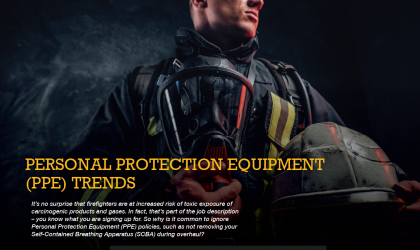In a Drexel University study, the following reasons for non-compliance were found:
- Firefighter identity– Acceptance of group cultural norms (e.g., what it means to work as a “real” smoke-breathing firefighter) as opposed to acknowledged safety standards.
- Goal seduction– In certain situations, firefighters are led to prioritize being “first-in” over their own safety, e.g., violating driving protocols or not taking time to put on PPE to get to the incident more quickly.
- Situation aversion– Firefighters may be led away from safe choices because they are inconvenient or uncomfortable or they think that choosing to be safe by wearing their PPE will invite ridicule and harassment from peers.
In addition, PPE has become complex and expensive. Personnel responsible for selecting and maintaining PPE have a difficult task when there is much to choose from and understanding the design, performance and limitations of PPE. These decision-makers must consider the equipment being more adaptive to firefighters’ needs yet still provide them with maximum protection.
The PPE industry is certainly changing and expanding every year with new technology and better materials.
According to The State of Firefighter PPE Report, published by Fire Rescue Magazine, we should be on the lookout for the following six trends over the next few years:
- Greater particle holdout capabilities in the protective ensemble, primarily in hoods and interfaces, with a minimum of firefighter encumbrance.
- More attention to garment, helmet and other elements’ weight, flexibility and comfort through more capable materials and components and through designs that better fit together with novel approaches to less stress-related wearing effects.
- More emphasis on integrated clothing systems that include elements designed to be worn together more effectively.
- Incorporation and standardization of ruggedized electronics capabilities in the ensemble for better communications, accountability and environmental sensing.
- Equipment with a broader function across a range of first responder missions through new designs and system convertibility.
- Clothing and equipment that is easier to clean and cleaning capabilities that make frequent maintenance and longer service life possible.
LION product designers recently described some of their goals around PPE optimization. These are good things to consider for any department making changes to their PPE purchases.
- Look for lighter fabric design to reduce heat stress and strain.
- Find more fitted products to adapt to firefighters’ daily routines. Firefighters “are industrial athletes and require turnout gear that fits better, is less bulky, and is more flexible.” Eliminate restriction as much as possible and allow freedom of movement.
- Make sure your crew cleans their gear! It needs to be taken seriously and cleaned more thoroughly and often than before. In fact, many departments are purchasing multiple turnout gears per firefighter so that decontaminated gear can be bagged at the scene and not brought back to the station.
Sources:
https://www.usfa.fema.gov/current_events/092817.html

